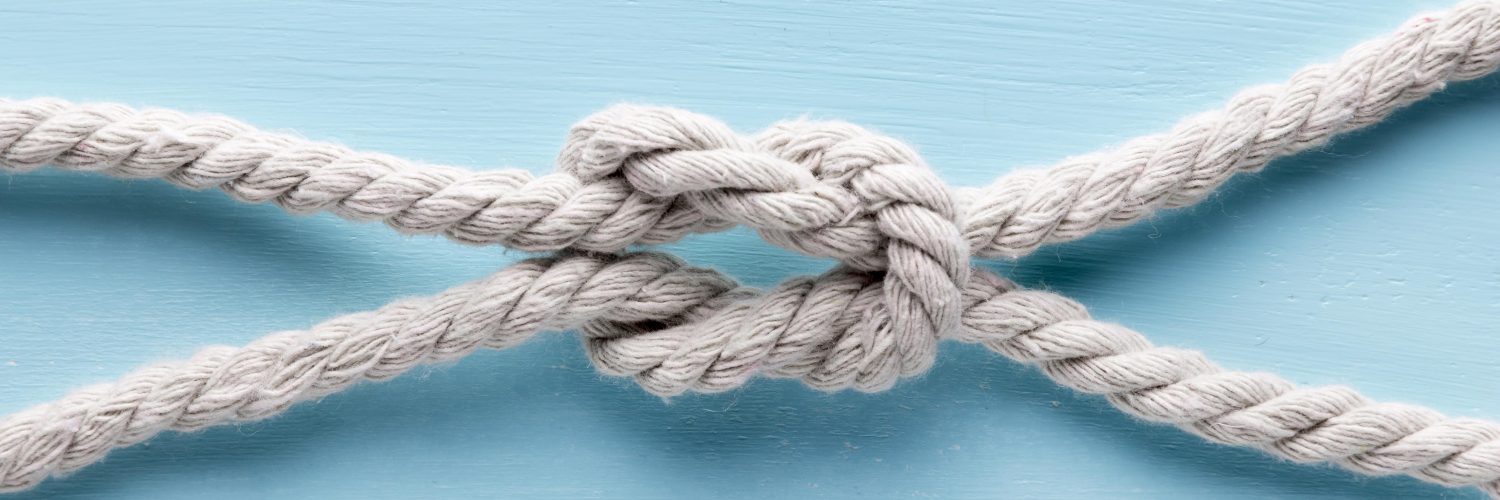Knot on Shabbos: Meleches Kosheir in Medical Practice (1)
{Editor’s Note: In the past two weeks, we focused on defining the Melacha of Kosheir. This week we will begin to discuss practical applications of these Halachos.}
In the previous essays, we discussed the definition of Meleches Kosheir, including the following topics:
1. The essence of the Melacha: tying a knot (or creating an attachment) that serves a purpose and is significant.
2. The difference between the Melachos of Tofeir and Kosheir: According to Rav Moshe Feinstein zt”l, if a person attaches two items by tying a knot that cannot be undone, he violates Meleches Tofeir, but if the knot can be undone, he violates Meleches Kosheir. According to Rav Shlomo Zalman Auerbach zt”l, it depends on whether the two items become a single entity or not. Attaching two things to become a single entity is a violation of Meleches Tofeir. If they remain two distinct items despite being attached, it is a violation of Meleches Kosheir. Tying an impermanent knot is not a violation of any Melacha at all, as an impermanent knot is considered only a “Shimush” (usage), not a creative act.
3. The dispute among the Rishonim as to the definition of a “Kesher Shel Kayama” ( a permanent knot): According to Rashi,it is permissible to form a knot that is likely to be undone on that same day. If the knot will last longer than that (though it won’t be permanent), it is Assur mid’Rabbanan to create it, but if a person does so, he isn’t liable (“Patur Aval Assur”). According to the Rif and the Rambam, there are two criteria that must be met in order for a knot to be defined as a Kesher Shel Kayama: the knot must be permanent, and it must be a “Kesher Uman” (an expert knot). If a knot will neither be permanent nor a Kesher Uman, it may be tied on Shabbos. If it will be either permanent or a Kesher Uman, it is forbidden to create it but one is not liable for doing so. According to the Shiltei Giborim, one may not create any knot that is tied tightly (a “Kesher Amitz”).
In this week’s essay, we will elaborate upon these themes and demonstrate practical Halachic applications.
Detaching or Cutting Through a Kesher Shel Kayama
The Mishna Berura (317:7, see also ibid. 23) cites a ruling of the Maharshal that if a knot may be undone on Shabbos, it may also be detached or severed. The implication of this ruling is that if a knot is a Kesher Shel Kayama and may not be undone, it would be forbidden to detach it. In short, according to the Maharshal, detaching a knot is tantamount to undoing it and would be a violation of Meleches Matir. Therefore, it would also be forbidden to detach an “intermediate knot” (which may not be formed on Shabbos but for which one isn’t liable), such as those that are used to tie cartons and the like.
However, the Mishna Berura elsewhere (314:31) implies otherwise. When he discusses cutting through a rope that has been tied around a box, he only considers whether doing so is a violation of Meleches Soser – not Meleches Matir. The Beis Yosef similarly omits any mention of Meleches Matir from the discussion of cutting through the strings around “Tz’li Of” (a roasted bird). This implies that cutting through something that has been tied does not constitute Meleches Matir.
Perhaps there is a distinction between cutting through the knot itself, which would be considered Matir (as implied by the Maharshal), and detaching or cutting through a rope that has been knotted which is only a matter of Meleches Soser (as implied by the second ruling of the Mishna Berura and the Beis Yosef).
This distinction may also have other ramifications. If a knot is unlikely to be untied but the rope itself will be severed, is it still considered a Kesher Shel Kayama? Clearly, if the knot itself will be cut apart, it would not be considered a Kesher Shel Kayama, but what if the rope will be cut in another place? According to the aforementioned distinction, cutting the rope in another place would not constitute Meleches Matir, therefore, the knot should be considered a Kesher Shel Kayama since it will never actually be untied.
Rav Shlomo Zalman Auerbach zt”l (cited by the Shemiras Shabbos k’Hilchasa 35, footnote 67) held that if a knot is tied in an item that will ultimately be discarded, it is not considered a Kesher Shel Kayama even if the knot itself will never be untied. If so, a knot in a rope that will ultimately be severed would certainly not be considered a Kesher Shel Kayama, even though the knot will remain intact.
However, Rav Shlomo Zalman had difficulty reconciling his position with a ruling of the Rivash (Shu”t 122) who appears to say that a knot that will be discarded intact and never will be untied, it is considered a Kesher Shel Kayama.
Nevertheless, it seems reasonable to assume that if a knot will not be a permanent Chibur (attachment) between two items, it should not be considered a Kesher Shel Kayama even if it will never actually be untied. Rav Shlomo Zalman similarly proposes that if a person has no intention or desire that the two items remain attached permanently, it cannot be considered a Kesher Shel Kayama. Therefore, even if a person ties a double knot in a plastic bag of food, but plans on tearing open the bag later in the day, it would not be considered a Kesher Shel Kayama.
Rashi (Shabbos 157b) explains that it is permissible to tie a knot with a blade of reed grass because it will ultimately break apart when it dries out. This supports our suggestion above, as it implies that it is not considered a Kesher Shel Kayama because the Chibur of the Kesher will not be permanent (even though the reed will not necessarily break apart at the site of the knot).
However, one could interpret Rashi’s comments differently. Rashi states, “The reason that a reed was used [in the case of the Mishna] is because it is animal food, and a person would not leave it as a permanent knot, since it will break apart when it dries out”. Rashi implies that the reason that it is not considered a Kesher Shel Kayama is because a person is likely to ultimately untie it because he knows that it will not last permanently and will break apart when it dries out. However, if that wasn’t the case, the fact that it will break apart is not a reason to render it a temporary knot. This interpretation of Rashi is clearly stated by the Meiri (ibid).
Practically speaking, is it permissible to remove hospital identification bands on Shabbos? The Shemiras Shabbos k’Hilchasa (9:15) permits it for two reasons:
- The wristband is only intended to remain attached to the patient until he is discharged. Therefore, it is not even considered an “intermediate knot” as it is not tied for an interval of time, rather, only until it is no longer needed.
- A wristband cannot be reused after it has been removed. Therefore, it cannot be considered an act of Matir which results in a string or rope that can be reused.
Moreover, it would also seem logical to permit removal of the wristband based on the discussion above. Even if the Melacha of Matir applies when detaching something by severing it at a place other than the knot, since the Chibur of the ID band was not intended to be permanent, it wasn’t a Kesher Shel Kayama and the prohibition of Matir would not be relevant. If the Melacha of Matir is limited to untying or severing the Kesher, there is no Issur at all to cut through the band on Shabbos!
Tying a Bow
The Gemara (Shabbos 113a) records a dispute between the Chachamim and R’ Yehuda as to whether tying a bow on Shabbos is entirely permissible or an Issur d’Oraisa. Why do the Chachamim take the lenient view and not consider a bow to be a knot?
It cannot be that they follow the opinion of R’ Meir who holds that if a knot can be undone with one hand it isn’t considered a Kesher[1], as the Halacha does not follow R’ Meir (Biur Halacha 317). Moreover, it is clear from the Gemara that a bow is not considered a “loose knot”, and therefore, it is likely that even R’ Meir would forbid it.
We must say there is a different reason why tying a bow is permitted. In order to undo a bow there is no need to actually untie it – merely pulling one end of the string takes it apart. Therefore, though it is relatively tight, which is why R’ Yehuda forbids it, the Chachamim hold that it is not considered a Kesher at all. [2]
The Rambam (Hilchos Shabbos 10:5) explains that the reason that tying a bow is permissible is because it cannot be confused with a regular knot. This is consistent with his opinion that Meleches Kosheir requires a “Kesher Uman”. Therefore, although the Chachamim did forbid other knots, they only did so with those that could be confused with a Kesher Uman. However, the Rishonim who argue with the Rambam and do not require a Kesher Uman in order to violate Meleches Kosheir (and any Kesher Shel Kayama is Assur) must hold that a bow is not considered a Kesher.
Cable Ties
Today, it is more common to bind items together with cable ties or twist ties than with ropes. Does the “Chibur” created with these constitute a Kesher?
One could argue that a Chibur is only considered a Kesher when it is formed by twisting and intertwining two strings or ropes in the form of a classical knot with which Chaza”l were familiar. On the other hand, perhaps Chazal considered any form of Chibur as a Kesher.
Rav Nissim Karelitz zt”l (Chut Shani 34:12) ruled that the Chibur created by cable ties is not considered a Kesher at all because it is not formed by tying two items together but simply holds the items together tightly. The Shemiras Shabbos k’Hilchasa (40:32) also permits their use.
Perhaps our earlier comments regarding bows would support these opinions. We discussed that a bow is not considered a Kesher, even though it creates a tight attachment, demonstrating that not every Chibur is considered a Kesher. On the other hand, we explained tying a bow may be permissible since it can easily be undone. It therefore resembles a lock, which is easily unlocked with a key, and is therefore not a Kesher. However, a cable tie cannot be undone and perhaps should be considered a Kesher.[3]
Furthermore, we also discussed that it would not be logical to say that a knot that cannot be undone would not be a Kesher (but rather might be a violation of Meleches Tofeir). On the contrary, the essence of Meleches Kosheir is that something is attached with a tight knot that we view as permanent, so certainly an attachment that cannot be opened would be considered a Kesher.
Therefore, there is good reason to consider the Chibur of a cable tie a bona fide Kesher. However, it would be no more stringent than a normal Kesher, and according to those who hold that only a permanent Kesher is forbidden, it would only be forbidden to use a cable tie if it was intended to remain permanently attached.
Although it could be argued that a cable tie should always be considered a permanent Kesher since it isn’t possible to undo it, but this isn’t completely accurate. If the cable tie is cut, the attachment also comes apart, therefore, it could also be considered a temporary Kesher.
According to the Rambam there is an additional reason to permit the use of cable ties on Shabbos as they are neither a “Kesher Uman” nor can they be confused with one. (However, perhaps the fact that they are manufactured in a sophisticated way should render them a “Kesher Uman”, despite the fact that they can be used even by laypeople and do not require expert technique. This question requires further study.)
According to the Shiltei haGiborim, the use of cable ties should be forbidden because they create strong attachments. The condition of “Kesher Uman” only dictates that a knot be tight, not that it be formed in an expert fashion. This is also the position of the Sha’arey Yosher (ibid.).
Nevertheless, as we noted last week, according to the Chazon Ish the opinion of the Shiltei haGiborim is a Chumra. Therefore, if a cable tie will only remain in place temporarily, a person may be lenient, but if it will be permanent, he should be stringent according to the Shiltei haGiborim.
At first glance, perhaps we should always consider a cable tie to be a permanent Chibur because even if it is detached, it will only be severed at a point other than the ratchet case. However, this is incorrect, as once a cable tie is cut, the remaining cable can easily be pulled through and out of the ratchet case.
In fact, even the Shiltei haGiborim who holds that any Kesher Amitz is considered a Kesher Shel Kayama, might agree that a cable tie does not constitute a Kesher, since cutting it at any point causes the Kesher to come apart.
Therefore, it is
permissible to use a cable tie if it will only remain in place temporarily. If
it will remain in place for a significant amount of time, using it would be an Issur
d’Rabbanan and permissible for the sake of a sick person. If it is intended
to remain in place permanently, it may even be an Issur d’Oraisa.
[1] Mishna, Shabbos 111b
[2] Rav Yitzchak Mordechai Rubin Shlit”a (Orchos Shabbos 10:12) also suggests this answer.
[3] See Shu”t Sha’arei Yosher 5:58 (R’ Asher Chananya Zt”l, d.2017) in the name of Rav Elyashiv Zt”l













